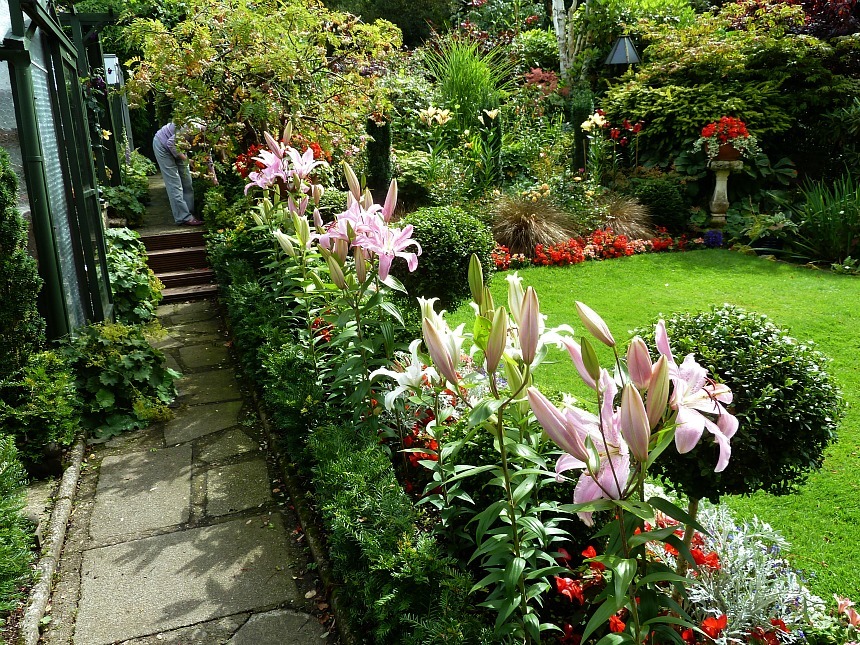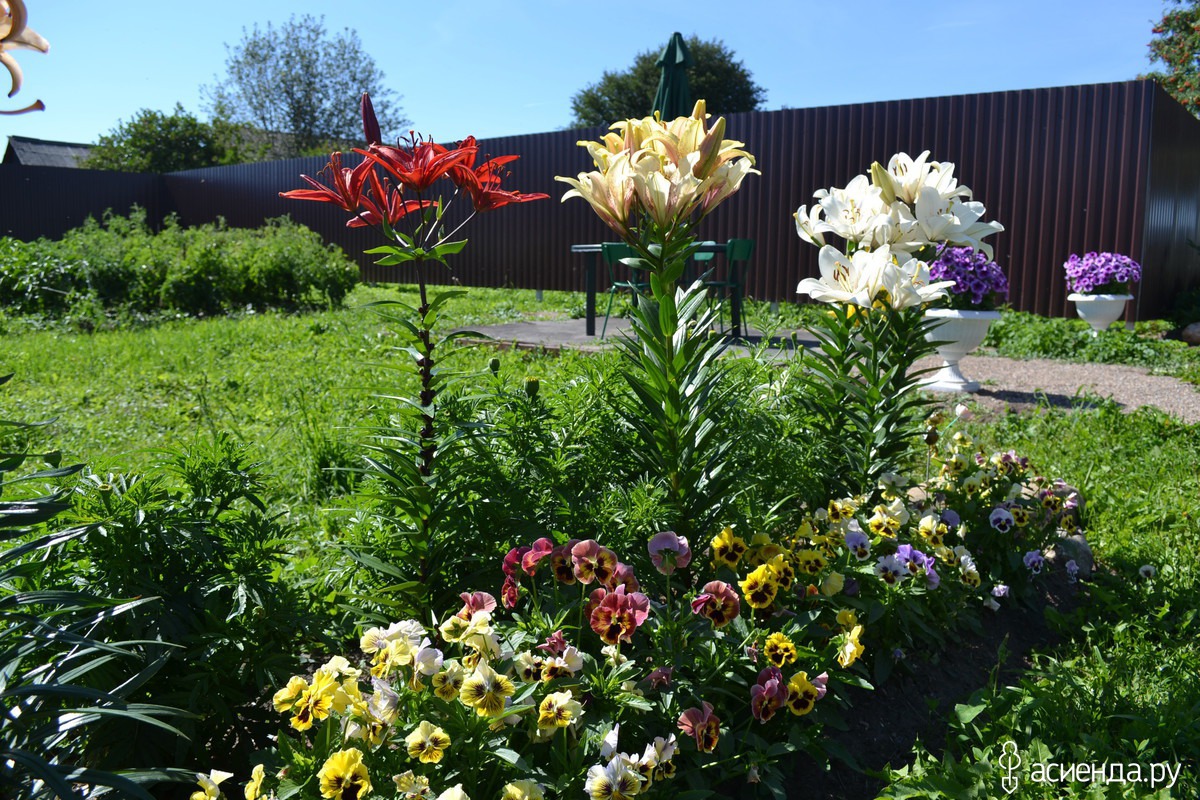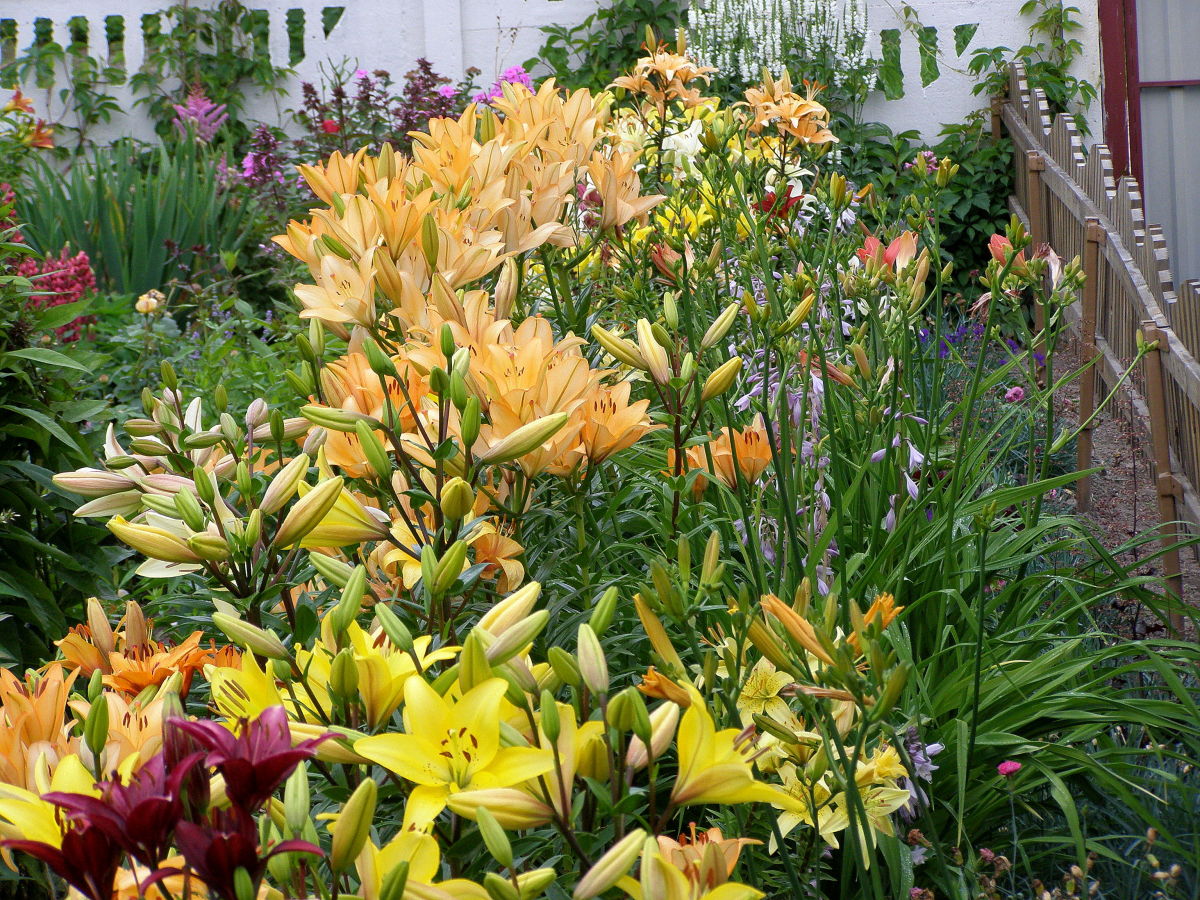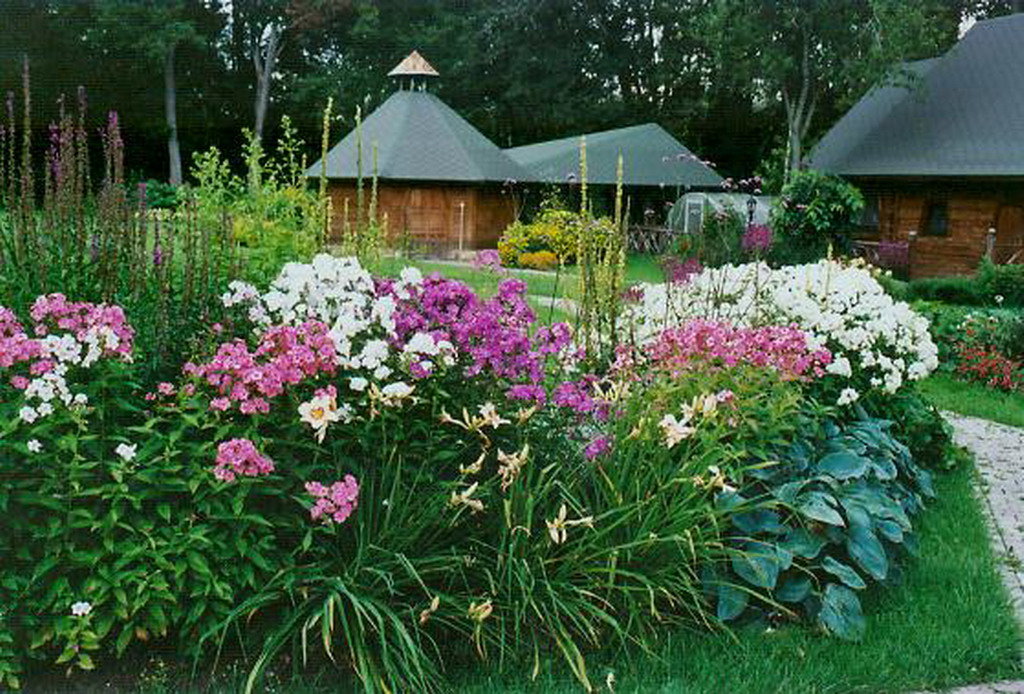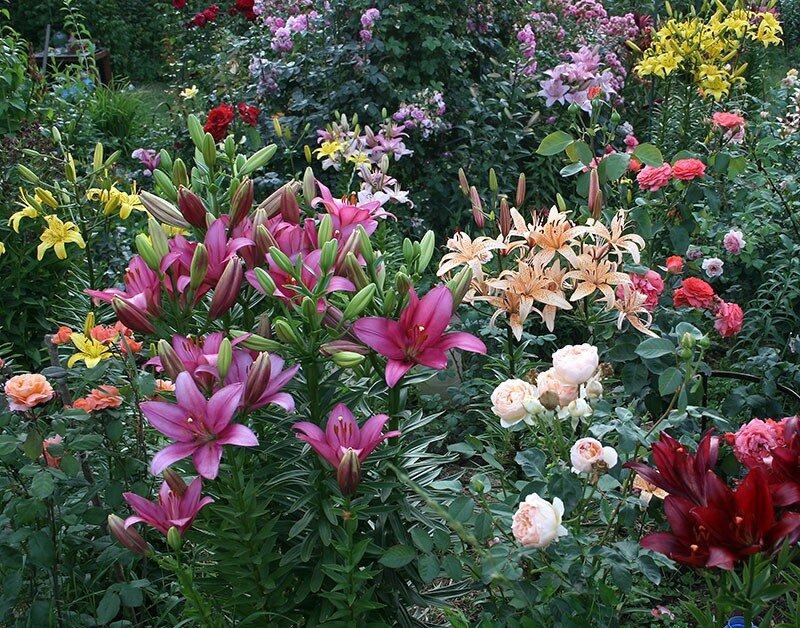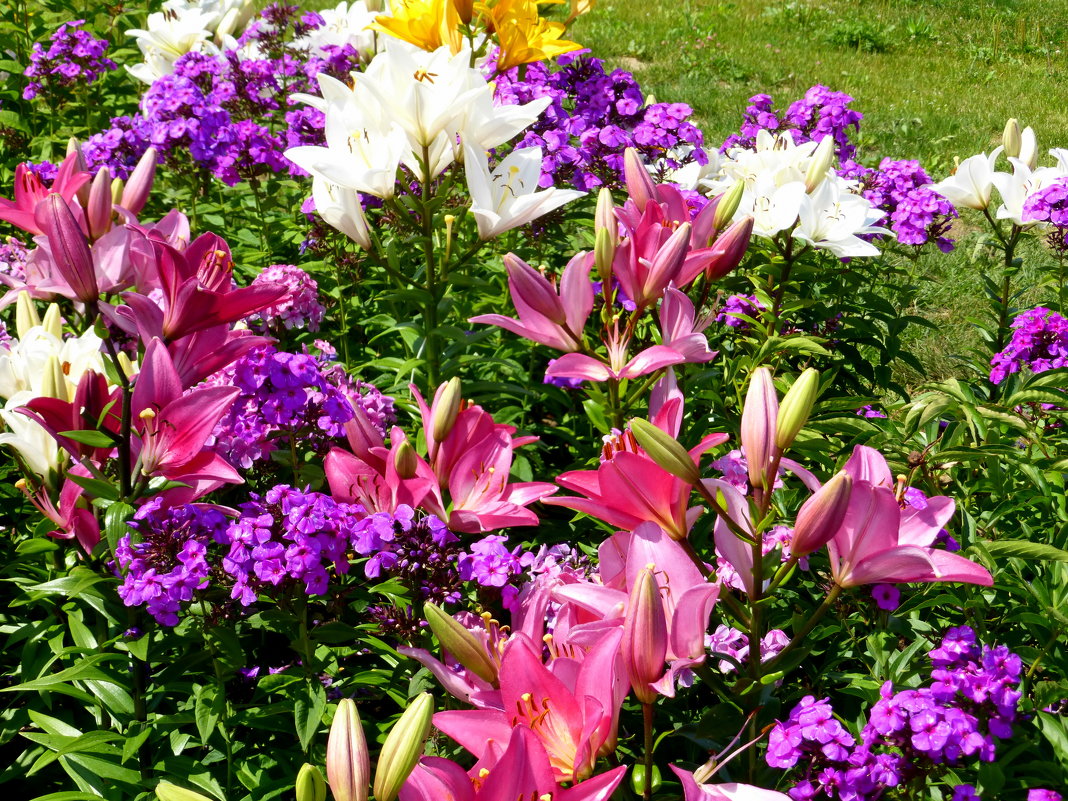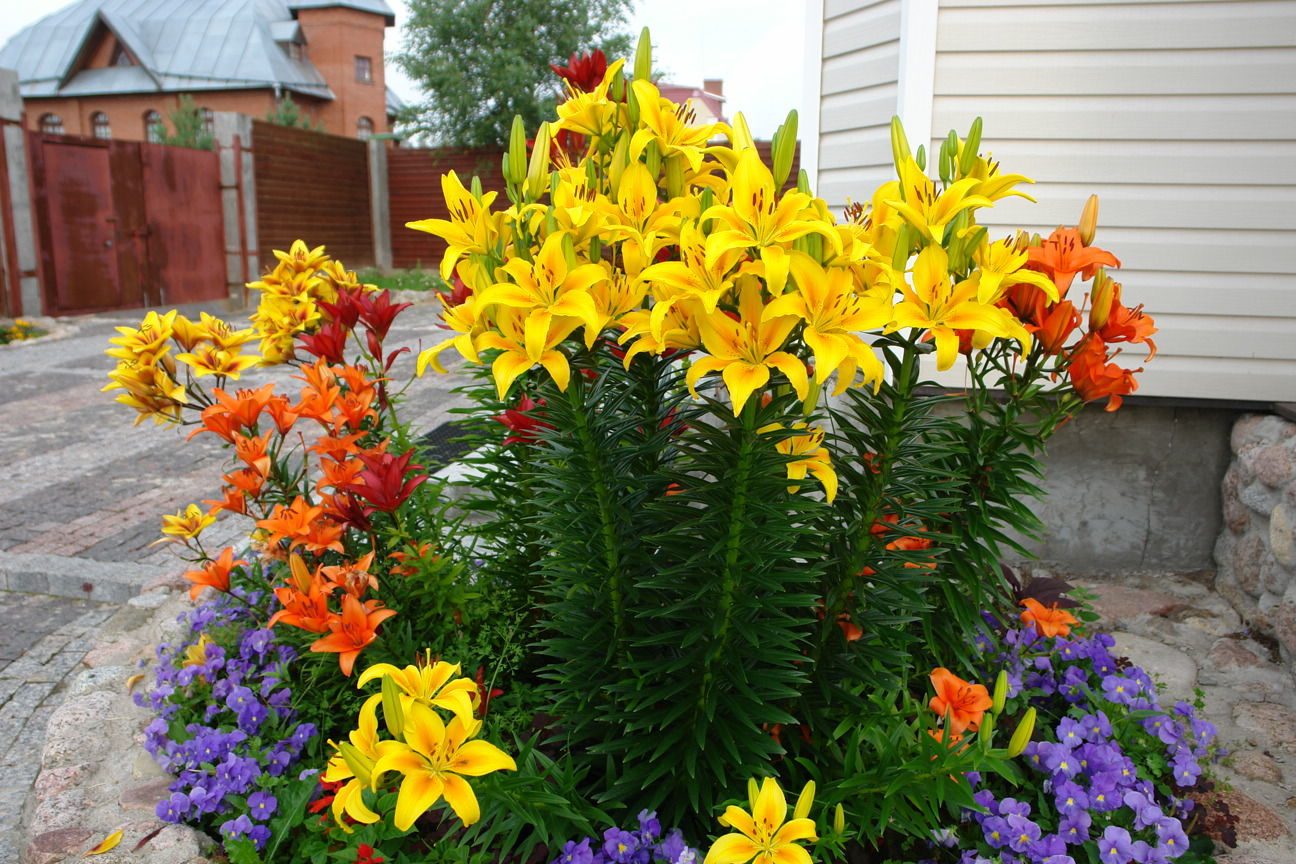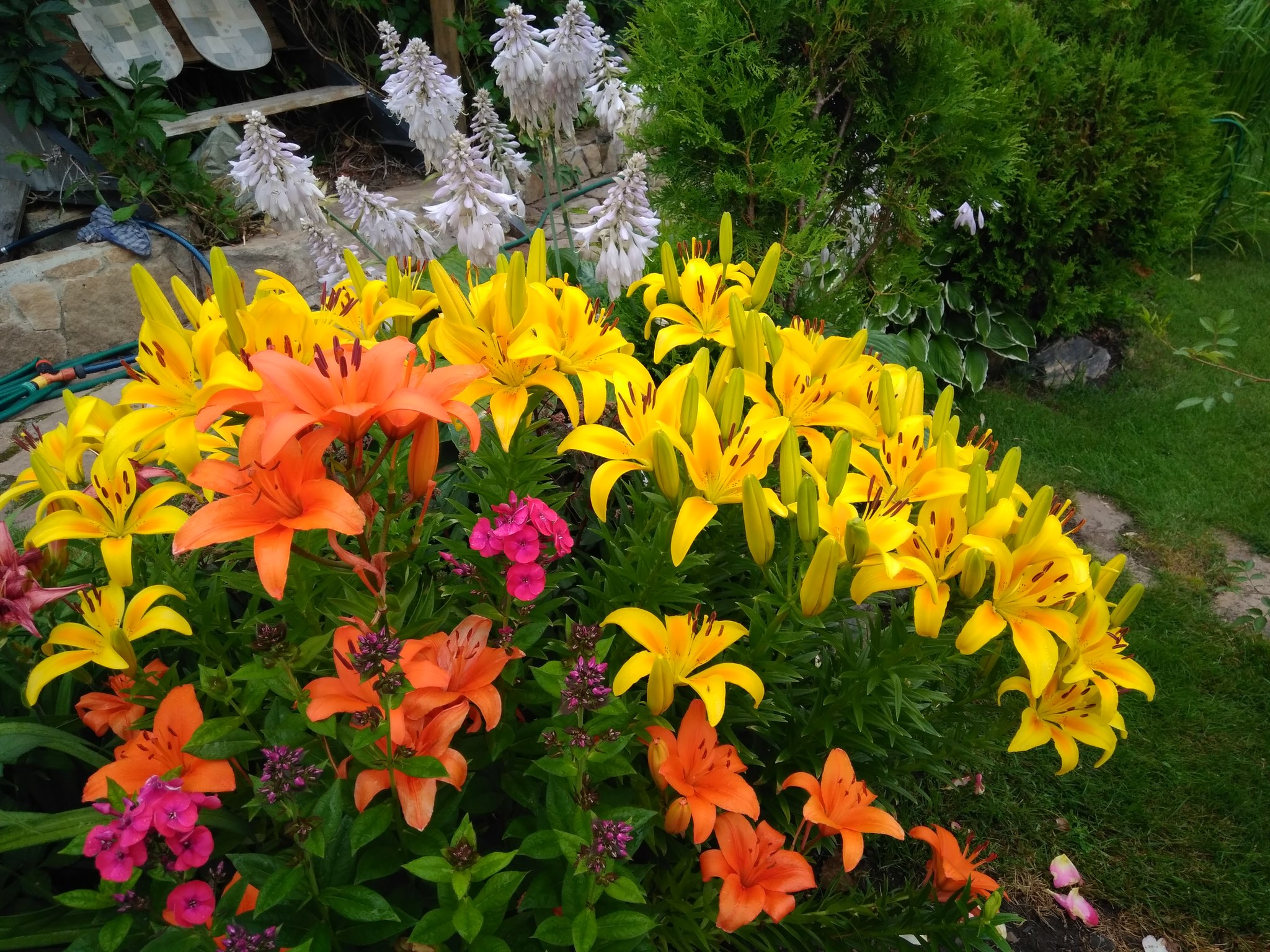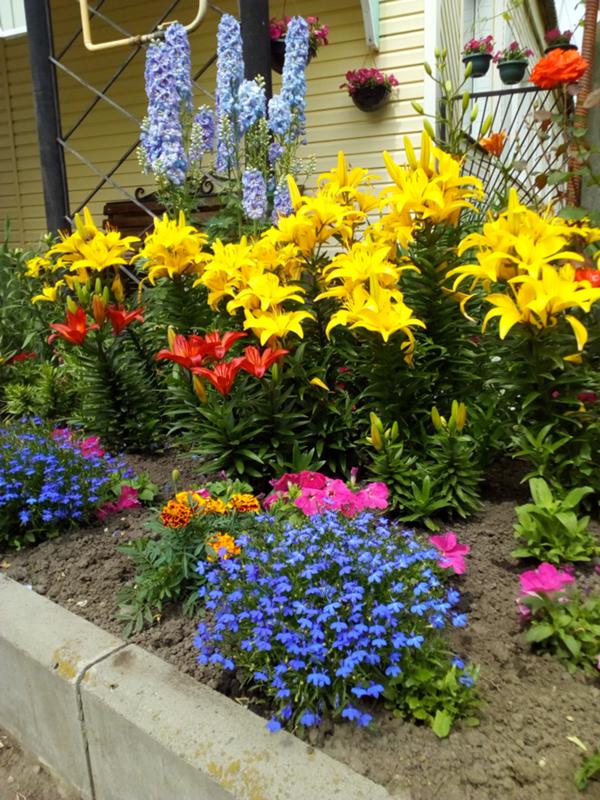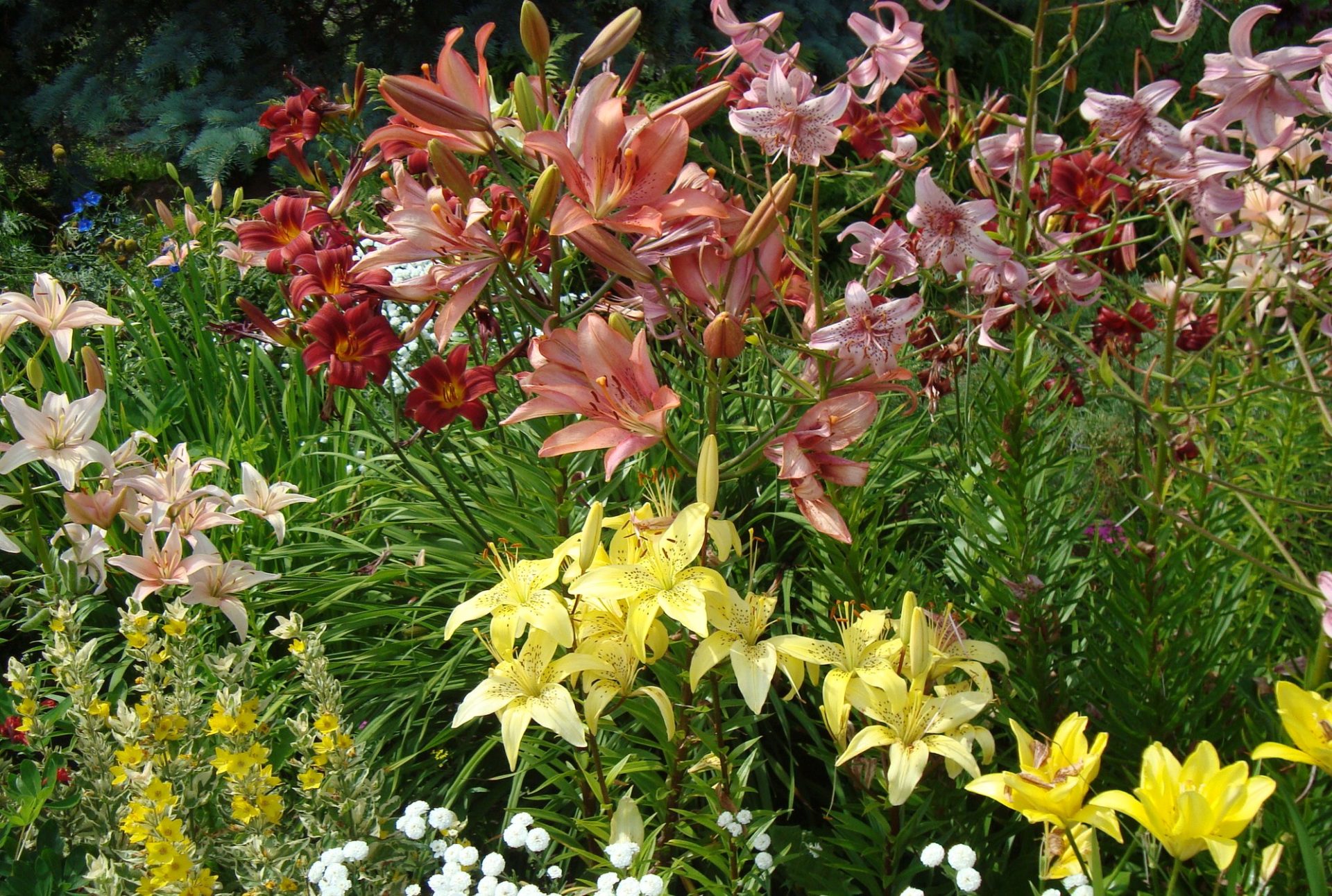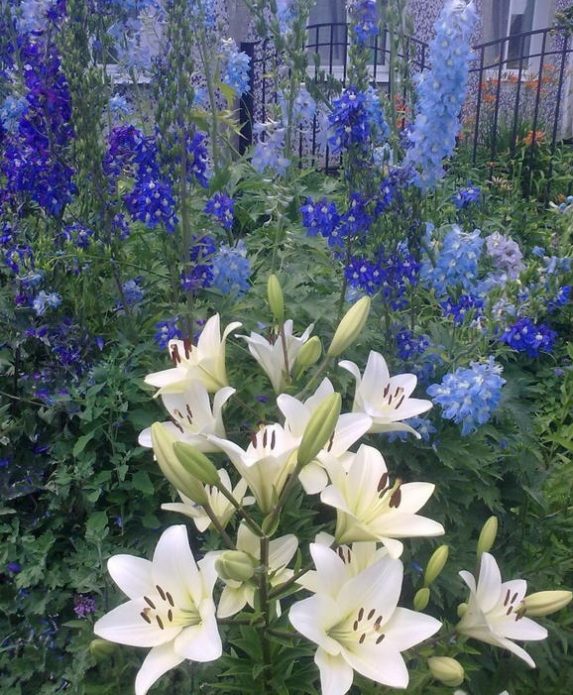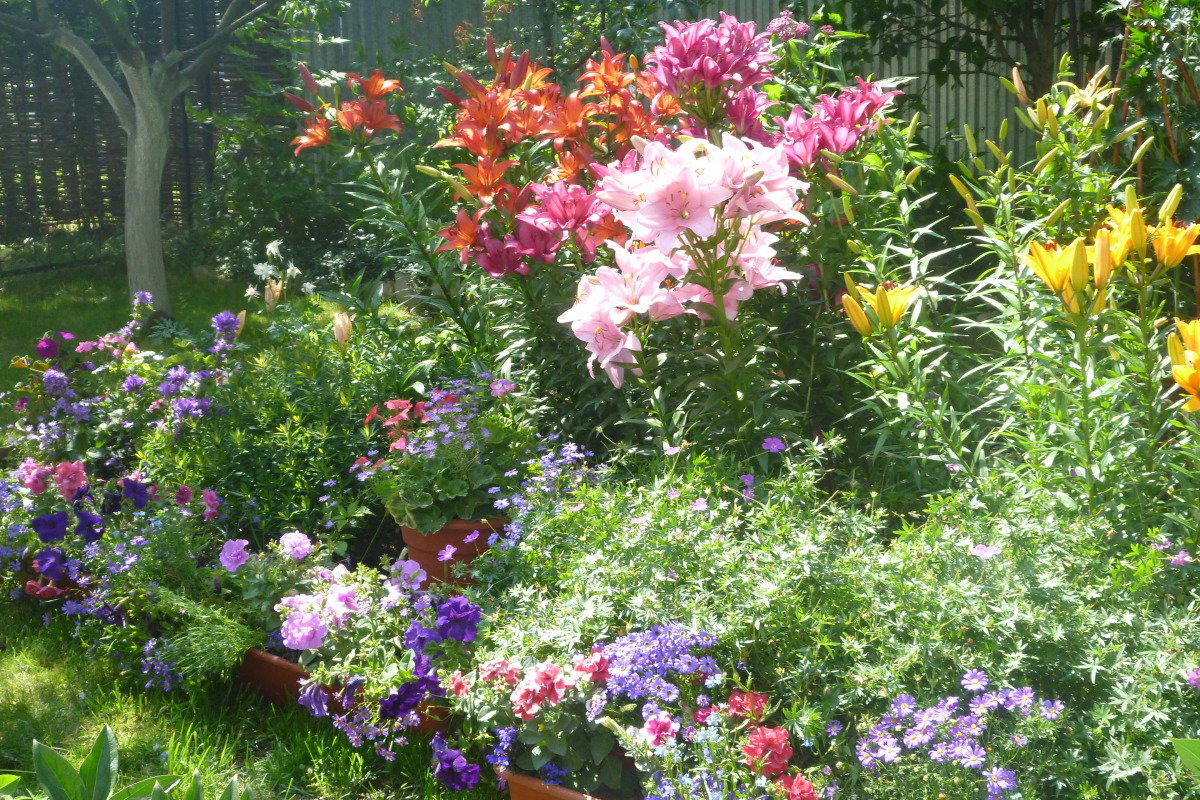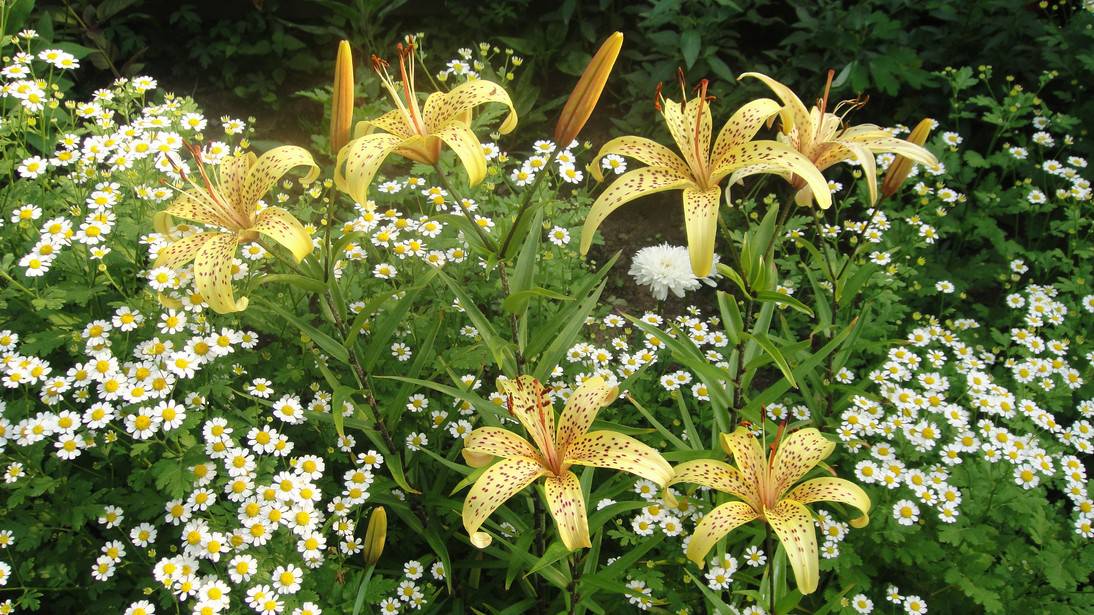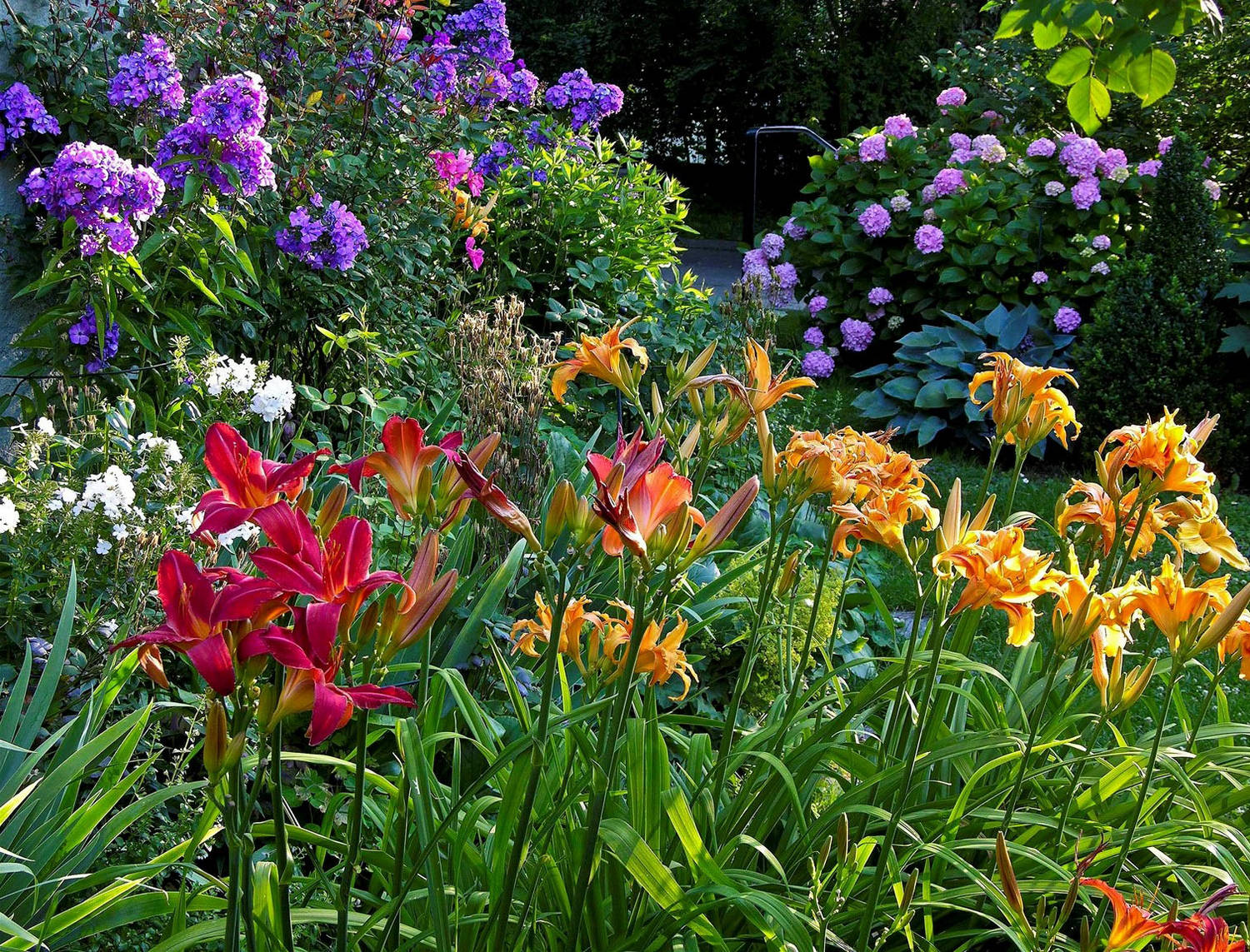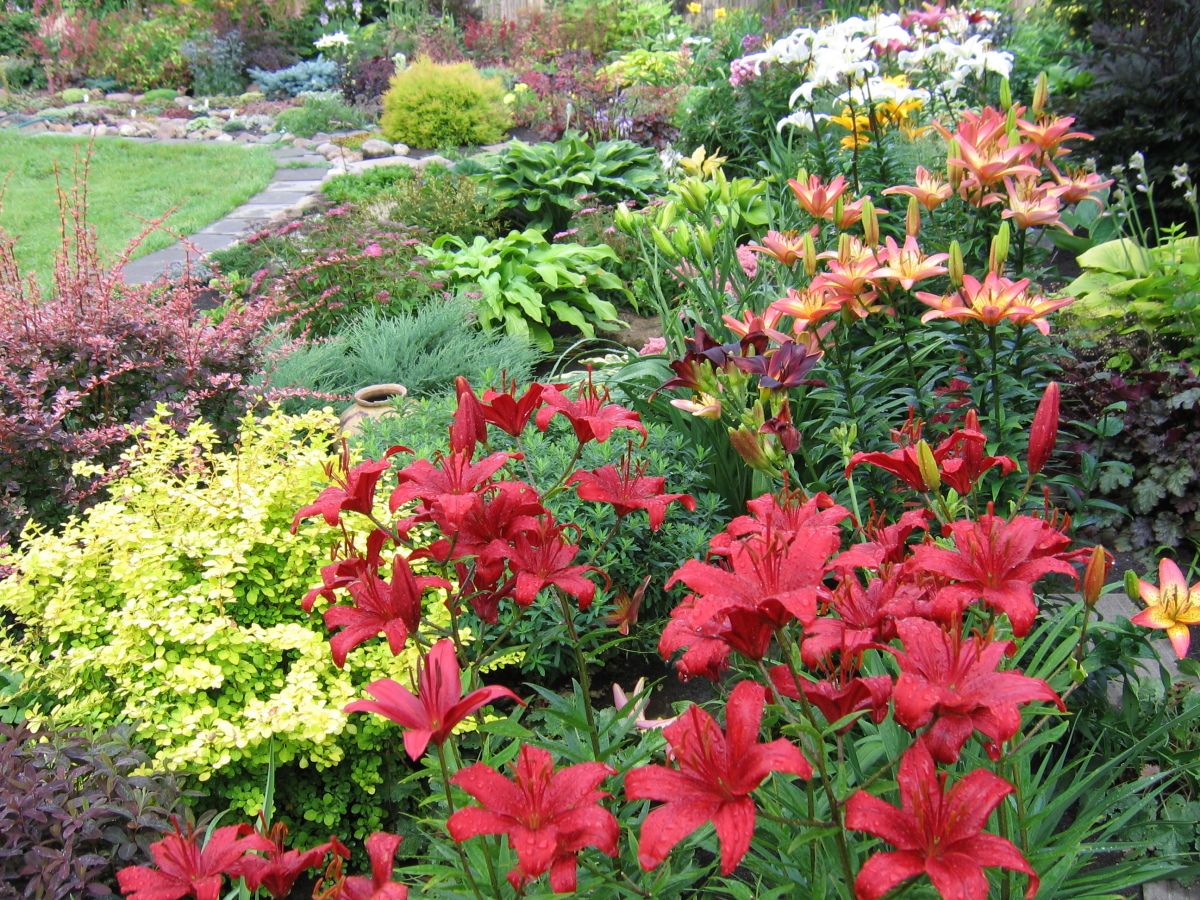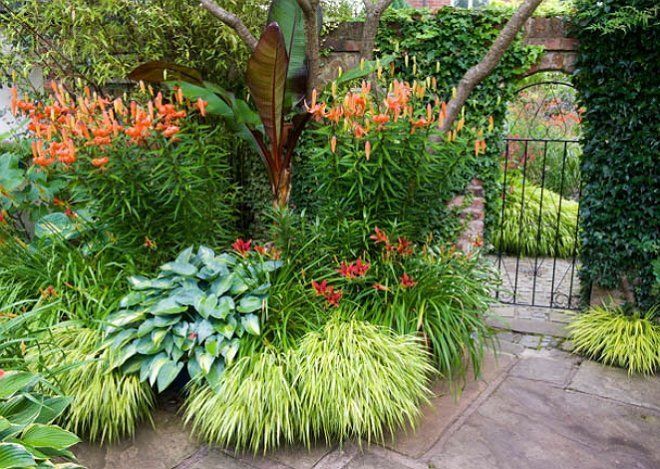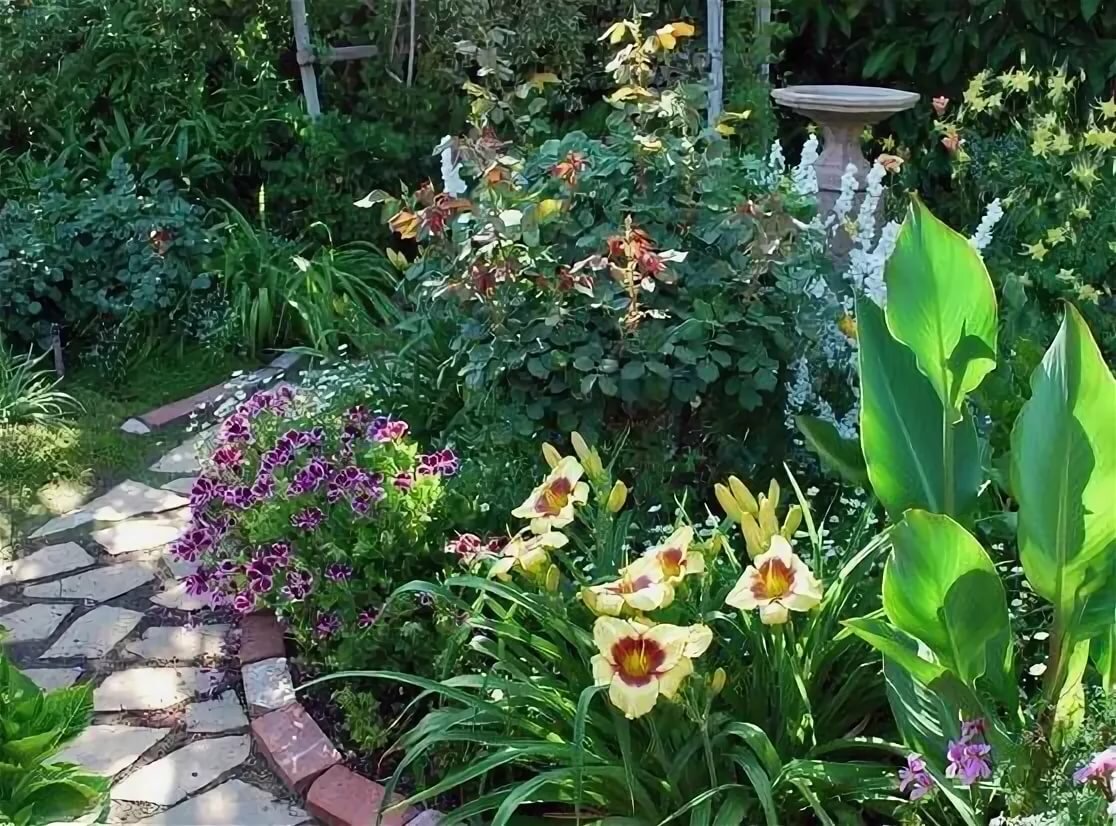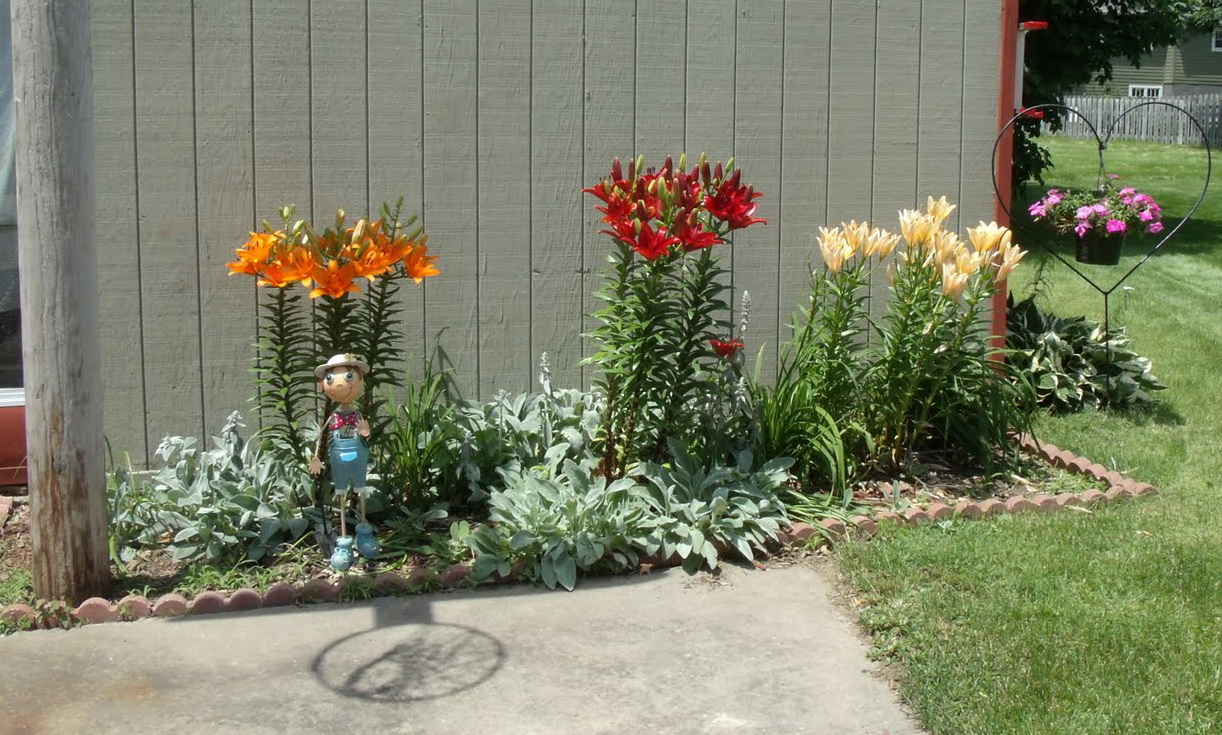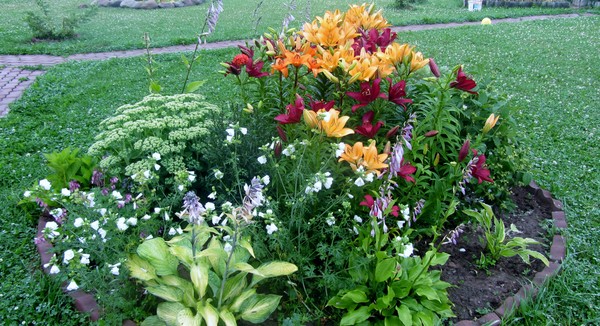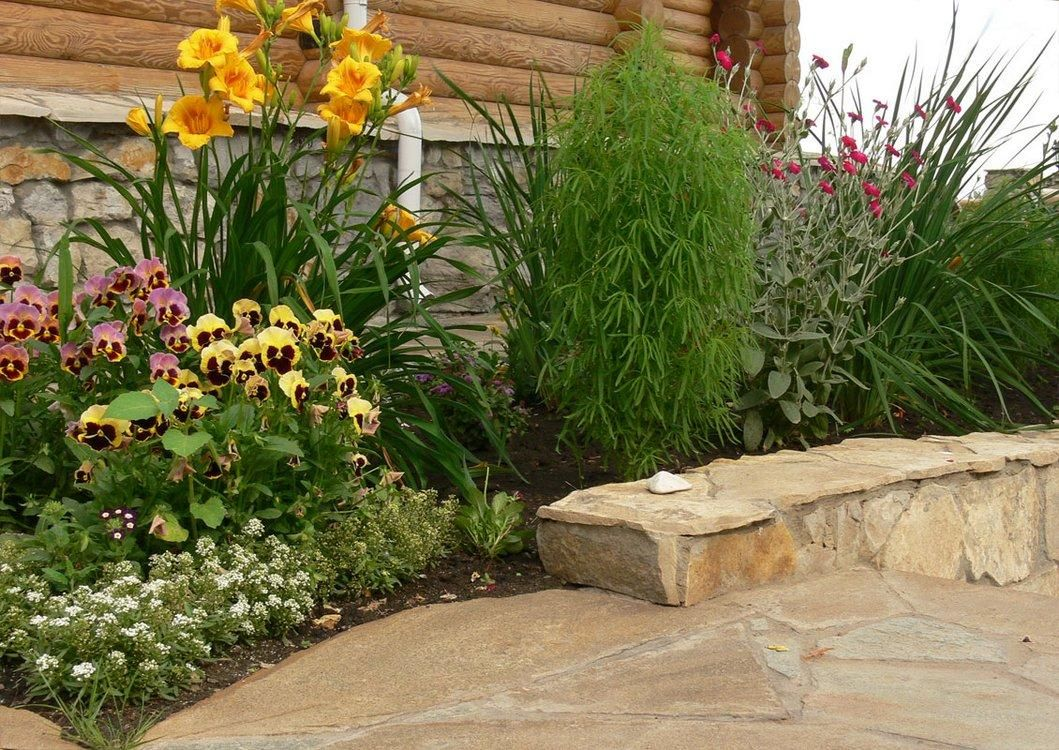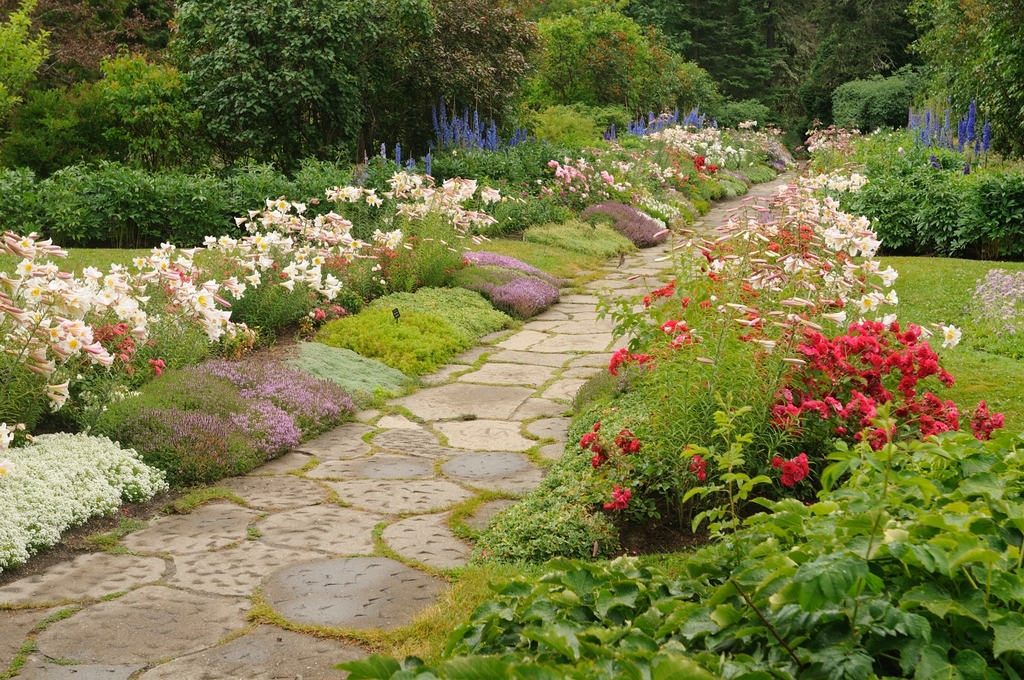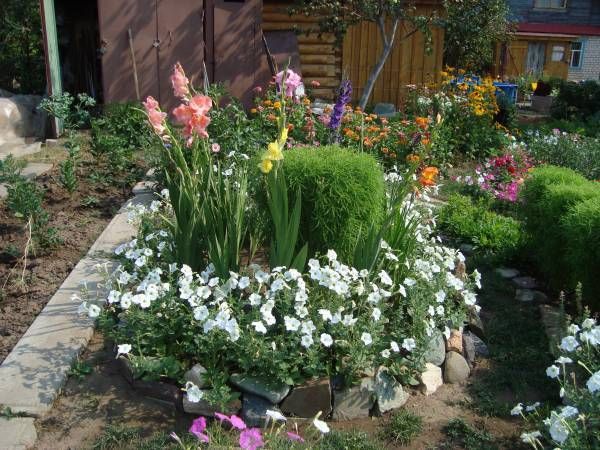Specificity of care
As a rule, lilies "sit" in one place for 3-7 years, after which they need to be transplanted and removed, otherwise a gorgeous varietal plant will turn into wild. In order for it to delight all these years with luxurious flowers, you must remember the following subtleties:
- The best time to plant is May or September. Bulbs planted in summer tend to dry out from heat or get sick.
- To prevent fungal diseases, the bulbs should be soaked in potassium permanganate before planting.
- At the bottom of a hole 10-15 cm deep, sand should be poured and an onion should be wrapped in it, and sprinkled with earth on top.
- The optimum distance between the bulbs is 25 cm.
- During the period of active growth and flowering of lilies, it is necessary to water them regularly so that the soil is moderately moist. To avoid the appearance of burns on the leaves, water should be poured only at the root.
- It is recommended to loosen the soil on a weekly basis, and in the absence of constant watering, it is necessary to mulch the lilies with grass or sawdust.
- You need to feed the flowers three times a season with complex mineral fertilizers, manure or peat.
- To prevent the bulbs from freezing, it is better to cover them with fallen leaves for the winter.
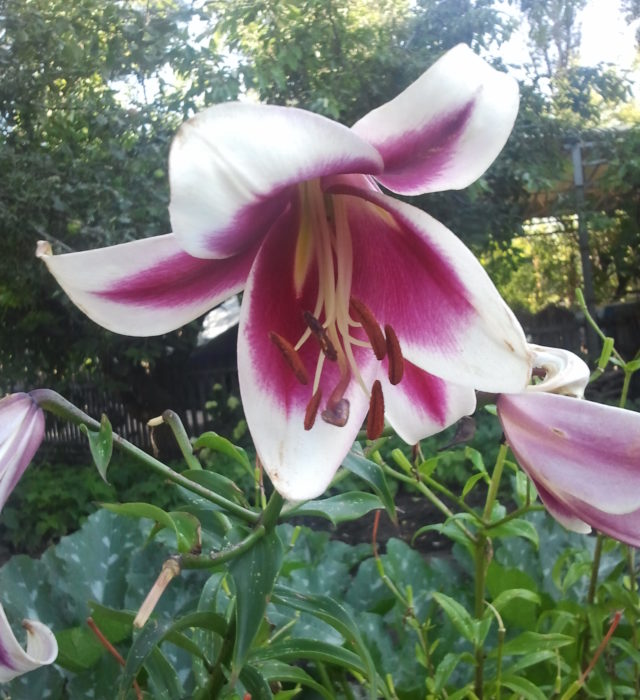 Lily
Lily
Flowerbed without weeding
The need for regular weeding near lilies often makes gardeners refuse to plant lilies on their plots. Rough weeds quickly clog the delicate shoots of lilies, and they soon stop growing altogether.
We suggest making flower beds of lilies with your own hands (photo is presented in the article), among the plantings of rhododendrons and astilbe.
A large flower bed in the middle of the garden, on which these large plants flaunt, will harmoniously perceive the neighborhood with lilies. Astilba takes root quite deeply, therefore, in a short time, it quickly and permanently displaces all the weeds that used to grow in this place. In such conditions, lily bulbs will feel absolutely excellent.
Lush rhododendrons will distract attention from the unsightly stems of lilies, and the flowers of the lilies themselves will look especially noble against the background of wax leaves of rhododendrons.
If the sight of bare ground seems dull and uninteresting, then it can be covered with a layer of well-dried and crushed tree bark.

Annuals and more
If you grow flowers from seeds, then this year only annual flowers will be able to bloom on your site. Some annual flowers bloom 13-15 weeks after sowing. These are tall marigolds, late asters, salvia, verbena, lobelia, petunia and some others. You can see and enjoy the flowering of these plants only if you grow them through seedlings. Other annuals can be sown directly into open ground.
Let's talk about them in detail.
Perfect lavater, spectacular zinnia, cheerful dahlias, fragrant matthiola, picky marigolds, airy eschscholzia, long-flowering Drummond phlox, captivating with its simple cornflower, lush cosmea, the well-known calendula, graceful godetia, a giant, ...
If you sow these flowers in early - mid-May, they will calmly grow on your site and bloom by July-August. Annuals are gaining decorativeness only from the middle of summer.
Growing plants in seedlings significantly speeds up the flowering time. And planting flower seedlings in a flower bed is certainly more pleasant than sowing seeds and waiting for shoots. Try growing seedlings of asters, zinnias, dahlias this year. It is not difficult at all, it should be done in mid-April, not earlier. At this time, there is already enough sunny color and the seedlings do not need to be illuminated with special lamps.
The best types and varieties of lilies for landscape design
Not every variety can be grown in the open field, while maintaining its decorative qualities and health. The choice depends on the appearance of the flower and its ability to adapt to weather conditions and soil characteristics:
- The Madonna's flower is popular all over the world - a white lily, a tall perennial that grows up to one and a half meters. It looks perfect in the center of the composition, covered from below by low plants, since the lower part of the flower is not particularly decorative.
- Trumpet lilies are no less famous and loved by gardeners. Royal and Chinese varieties are the most common in landscape design. The lily of Sargent can be attributed to the same category.
- The beauty and enchanting aroma of oriental varieties have gained legendary fame, but it is extremely difficult to grow them in open ground. They react painfully to both cold and heat. A way out of this situation was found when it was possible to cross the tubular and oriental lilies. As a result, we got an OT hybrid, beautiful, like oriental, and resistant, like tubular varieties, but blooming only in the second year.
- It is worth noting such a variety as Belamkanda. She is distinguished by an interesting leopard print on bright orange petals, for which she was named Leopard Lily. A beautiful and delicate flower does not tolerate winter cold and requires a transplant for the winter indoors. But admirers of its unusual appearance are ready for the difficulties of transplanting and caring for a capricious variety in order for it to set the tone for the design of the site.
It will also be interesting: When to cut lilies - after flowering, for the winter and whether it is necessary
Flower garden with peonies
Before you start drawing up a flower garden plan, you need to know that:
- Peonies have been growing in one place for many years and often cannot be transplanted, so the place must be selected very carefully.
- A young plant will gain strength for several years and only then will it take its rightful place among flowers.
- Peonies are always the dominant flowers, so it is better to choose one variety and select companions for it.
- The flowering period for peonies begins in mid-May. Herbaceous species bloom for about two weeks, while tree varieties, with good care, can bloom for 3-4 weeks.
- When planting, it must be borne in mind that adult bushes need a support during the flowering period. Huge inflorescences with their weight incline the stems to the ground. The bush takes up a lot of space.
- Once the peonies have bloomed, their dark green, narrow and long leaves will serve as a great backdrop for other plant flowers.
- Peonies look great when grown in groups or single bushes in a green lawn. In this case, you can choose several varieties of different flowering periods and colors, harmoniously complementing each other.
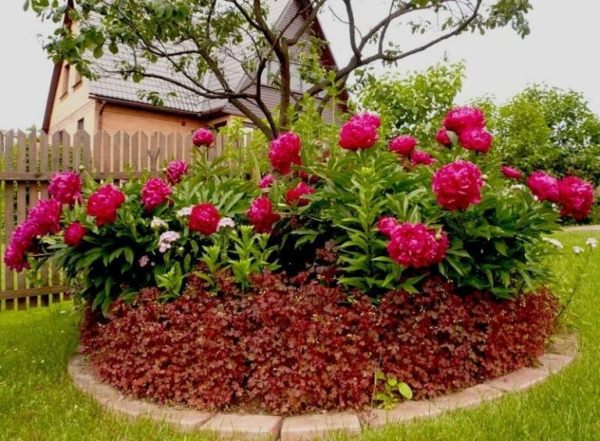
Flowerbed with peonies
Important! The richness of colors and shapes in hybrid peonies is so huge that it is better to choose two varieties for a group that emphasize the beauty of each other in color and shape, than to create a cacophony of many magnificent, but not suitable for color varieties. Considering all these features of creating a flower garden with peonies, you can easily determine the place and shape of the flower garden.
Considering all these features of creating a flower garden with peonies, you can easily determine the place and shape of the flower garden.
What to plant with
Lilies should not be planted next to irises. Despite the fact that they have different flowering times, and in appearance these plants seem to be compatible, such a neighborhood will adversely affect both. The fact is that faded irises should never be watered. Their main root, located on the surface of the earth, will quickly rot, and lilies during the flowering period require regular moistening of the root section of the soil.
The second unfortunate neighbor of the lily is the tulip. These flowers have common diseases.
In addition, tulip bulbs invariably attract the attention of mice. Having torn the tulips, they will also gnaw the lily bulbs at the same time
And they, especially varietal ones, are very expensive and are rarely available for sale.If you want a flower bed with lilies to delight with flowers all summer, starting in spring, plant daffodils or a grove near it.
Experienced gardeners, who do not want to part with tulips, dig in lily bulbs along with plastic or metal cans. With their walls, they block access to them for both mice and other pests.
The jar is trimmed at the top and bottom and hammered into the ground around the bulb with a hammer. This will subsequently make watering difficult, but will keep valuable specimens from garden vandals.

Placing daylilies in the garden
Low-growing varieties of daylily can become the main decoration of the paths leading to the house, to the gazebo in the garden or into the depths of the garden. They are also appropriate to use when decorating alpine slides, rockeries, peculiar frames along the edge of a flower bed.
Near the seating area or along the terrace, it is appropriate to plant several bushes of daylilies with a delicate aroma, so that they delight the eye with their exquisite flowers and spread the fragrance.
Daylilies will fit perfectly into the design of the coastline of the reservoir, planted together with other plants.
It is good to use plantings of flowers in such places of the garden, for which there is no way to carefully look after, but you need to decorate them. Daylilies will do well with this task, becoming a decoration of the area.
Planted on a slope against a background of lawn grass or in combination with other plants, daylilies will turn it into a major decorative element of the design.
Arrangement of flower beds with lilies
In the garden, lilies need to be combined with the rest of the plants. In order for lilies to look beautiful in your garden, they need to be planted, imagining in advance how they will look with other plants and trees, with shrubs and decorative elements.

Each variety of lilies has its own botanical and decorative features that must be taken into account when creating compositions - these are the size, height and shade of flowers, the duration of flowering, and care features.

In the garden, a flower garden looks good, which is created from lilies of a diverse group, as well as from various varieties of the same group, planted in several tiers. This multi-tiered array of lilies looks very impressive.

In the foreground, low-growing varieties of lilies create a beautiful rug - they are chosen among Asian or LA hybrids. It is best for the lower tier of lilies to bloom first, and then the middle and highest tiers bloom - they are formed from tall OT-hybrids of lilies.
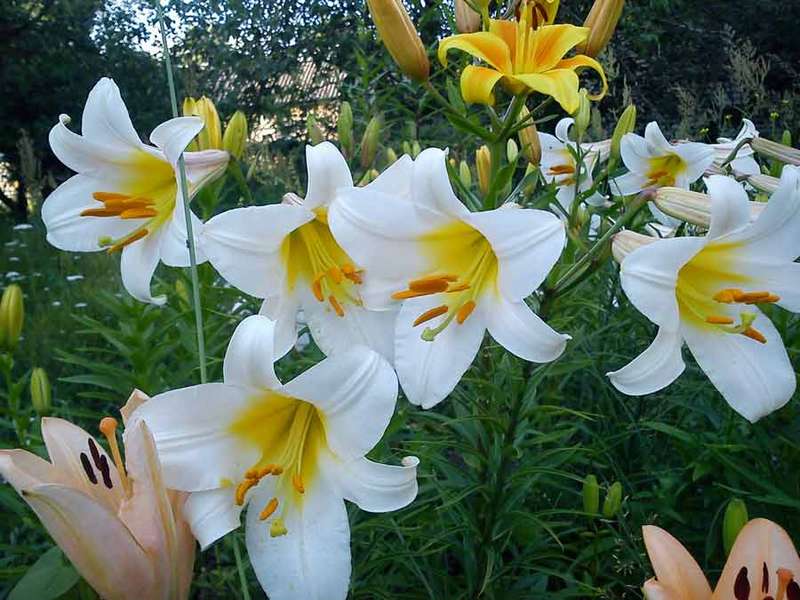
When planting lilies in the garden in species groups, it is better to divide the tiers with other garden flowers. Low-growing conifers that grow well and cover the soil are well suited for planting in front of lilies. Of all the ornamental plants, lilies are best combined with peonies. In front of the peonies, a group of low lilies together with ground cover phlox looks spectacular.
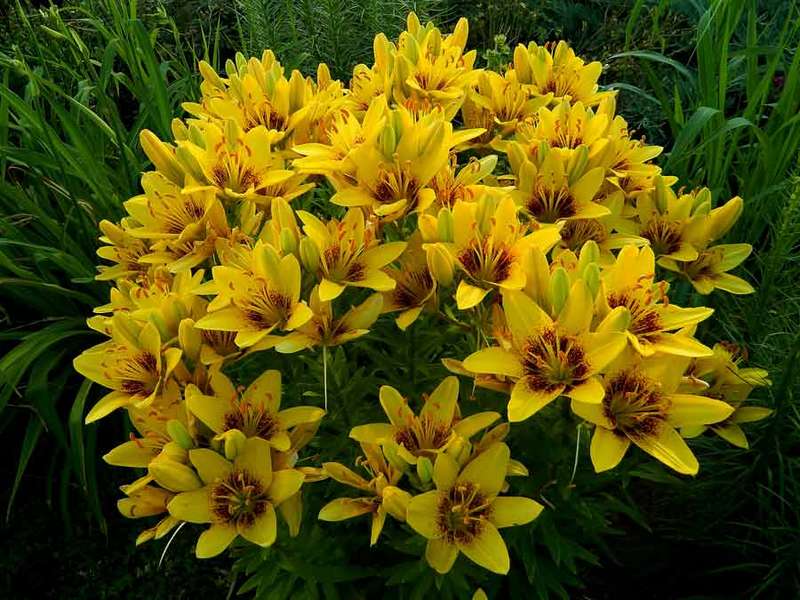
Lilies and irises are not successfully combined, the foliage of which dries after flowering and loses its decorative effect - at this time irises do not require watering, but lilies need it.
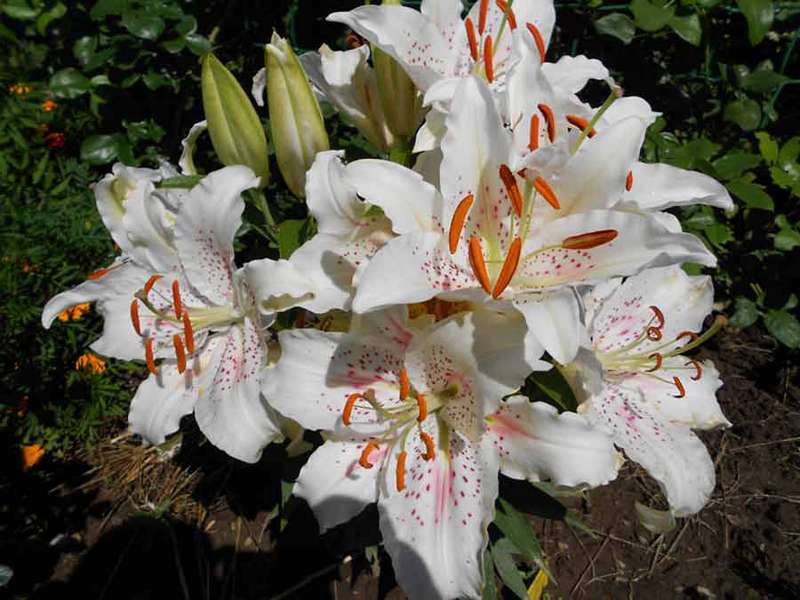
For borders, you can use low types of lilies of any color.
An interesting duet is formed by evergreen coniferous shrubs and lilies.

The emergence of all new varieties of lilies with a wide shading palette and decorative properties allows them to gain a stable position in the garden, decorating curtains, flower beds, borders with their appearance.
Flower bed layout
Before organizing a simple flower bed, you should carefully plan what and how to plant, in what order and color scheme. And for this, a couple of tips come in handy.
Absolutely all flowers move their heads following the sun. And therefore, if the view opens to the flower bed from the north side, then most of the day the flowers will be turned away from you. It is recommended to plant flowers on such a bed that do not follow the sun so clearly. These include: marigolds, zinnias, irises, lupine, Buzulnik Rocket, delphinium.If the site for the flower bed is located along the fence, through which people passing by can admire your flowers, then make a choice in advance: the flower bed will have to delight you or passers-by. When sowing seeds, a sufficient distance should be left between the different groups of plants. Better at the end of June, the flowerbed will look a little empty, but in July you will not have to free some plants from others, more aggressive and spreading
When planning a flower bed, careful attention should always be paid to the height of the selected plants, which is usually indicated on the seed packaging. You also need to follow the recommendations for the distance between them.
If the seedlings are too frequent, they can be carefully dug up and transplanted. However, some plants do not tolerate this procedure very well. If you decide to collect seeds from flowers that have a certain shade, then do not be lazy and mark the selected plant in advance, immediately after the beginning of flowering. Since the next weekend the flowers can bloom and get lost among the "comrades" painted in a different color scheme. For prolonged flowering of annuals and perennial flowers, it is necessary to remove from time to time already faded inflorescences, as well as fruits and ovaries. Thus, you can maintain the decorative effect of your flower bed. Do not sow seeds of the same species over too large an area. When the time of its flowering has passed, you can get a very unsightly, empty area, which can very much disrupt the holistic look of a simple flower bed. It should be noted an interesting property of some flowers, for example, escholzia, the buds of which close in cloudy weather. And the tricolor bindweed closes with the onset of the afternoon. But mattiola, on the other hand, opens up and begins to smell fragrant only in the evening and at night.
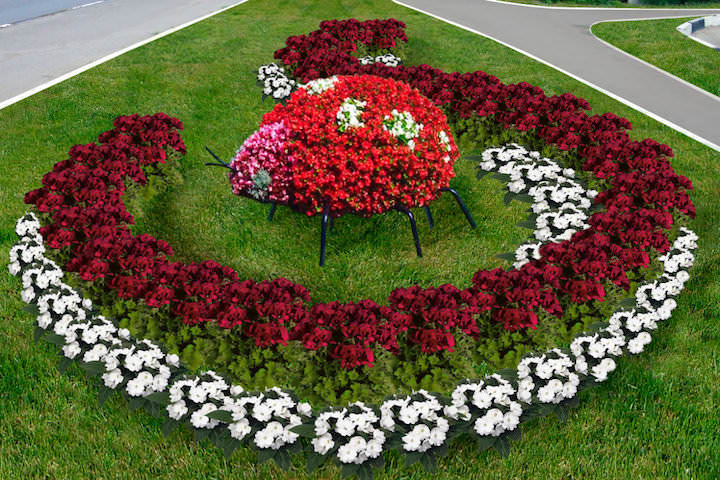
Where to plant the lily?
Choosing the right site for planting lilies is half the success in growing it. Despite some moodiness, the plant will endure both heat and rain, if it is in a convenient place that is protected from the wind. Also, the flower bed should have a slope or elevation to prevent stagnation of melt and rainwater. Ideally, the lower part of the plant should be in the shade, and the upper one in the sun, which can be easily done by planting low-growing perennials or ornamental grasses next to the lilies.
The main requirement for the soil is moderate acidity. If it is too high, it is recommended to fertilize the ground with wood ash (150 g per square) or chalk (200 g per square)
It is important to understand that the roots of lilies go to a depth of 1 m, so before planting, you need to dig up the ground well, adding sand if you have to deal with heavy clay soil
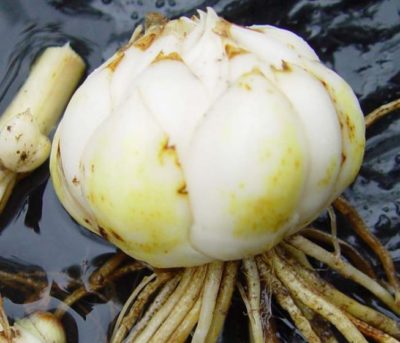 Lily bulb
Lily bulb
COMBINATIONS WITH LILY - (compatibility of other flowers)
1. Lily ‘Scheherazade’ with slightly curled petals, layered oriental beauty,
attracts the eye. She is prima in this composition, and all other plants (monarda, scabiosa, baptisia, feather grass) are designed to emphasize her charm.
2. The joint planting of a rose and clematis is considered almost classic, but look how harmoniously the combination of blue clematis and pale pink lily looks! And as a filler plant - lavender.
Z. And here is the same marchagon lily, a species plant and its white-flowered form. They will look great among just about any plant.
4. Delicate pink lily Elodie considered terry, although not everyone pleases with double flowers, for example, only the rudiments of the second row of petals are visible in the photo. But even in this form, it is attractive and combined with iris and hosta.
5. Bright lily (from the Asian hybrids group) and very bright rudbeckia are a recipe for raising the mood.
6. Contrasting combination of peach lily and dark violet-blue delphinium. Here the contrast is not only in color, but also in the shape of flowers and inflorescences.
7.And again the ‘Scheherazade’ lily, but look: in a completely different capacity! Here she is no longer a diva, but only one of the plants of the composition. Next to cannes, agapanthus, it no longer looks so majestic.
8. The pompousness of peach lilies can be softened by large ammonia - an excellent plant with delicate white inflorescences.
Lilies in the country: how to care for and grow beautiful flowers
In order not to damage the lily bulbs, the marigolds should not be dug out in the fall, but cut off at ground level.
Heat-loving lilies grow well in containers, which can serve as flower pots, ceramic vases, boxes, tubs. They are good for decorating a variety of places: balconies, terraces, patios, paths, rocky hills.
Low dwarf lilies are also best grown in containers or on alpine slides. Tall lilies (2 m) are effective as a background for a one-sided border. Plants of medium height, which are most varieties of lilies, are picturesque not only in the borders, but also in the flower beds.
Lilies can be grown as indoor plants, but in this case, you need to specially select the species. For example, Long-flowered hybrids grow well in an apartment. There are also special potted low lilies (pixies). For lush flowering, indoor beauties need coolness and so that direct sunlight does not fall.
Advice
Lilies can decorate the garden from late May to September inclusive. Early flowering in LA hybrids, from mid-June, Asian hybrids bloom for almost a month, then Tubular and Orleans, and last - Oriental hybrids.
N. Ya. Ippolitova, Candidate of Agricultural Sciences
Fight disease
Although lilies are not highly vulnerable flowers, they can suffer from infectious, non-infectious and viral diseases, not to mention pests. The former include gray, basal, root, white and soft rot, as well as fungal diseases in the form of penicillosis and rust. Pathogens enter the plant from contaminated soil or rain, after which they begin to grow rapidly in case of high humidity. The easiest way to prevent the disease is to pickle the bulbs before planting with a solution of foundationol or potassium permanganate.
When the first symptoms appear in the form of decay and yellowing of the leaves, they must be sprayed with foundation. You should also disinfect the soil with copper sulfate or formalin (250 ml per 10 liters of water) and do not forget about dressings, which play an important preventive role.
Non-communicable diseases are those that slow down the growth of lilies and appear due to unfavorable garden conditions, namely:
- chlorosis (yellowed leaves) - occurs due to increased acidity of the soil;
- purple coloration of leaves - appears due to poor aeration of the soil;
- fasciation (fusion of two or more stems) - surprisingly, this phenomenon occurs with ideal technological care and lasts a maximum of one year, after which the lily grows normally;
- A “sleeping onion” is when a planted bulb emerges only in the second year.
If these troubles can be fought, then viral diseases cannot be treated. Rosette disease, tobacco and cucumber mosaic and other viruses suppress the plant, bending the stems, changing the shape of the leaves and impairing the decorative qualities of the lily. The affected bulbs are removed. In the future, prophylaxis is carried out. First of all, it is the fight against aphids, which are the vectors of viruses.
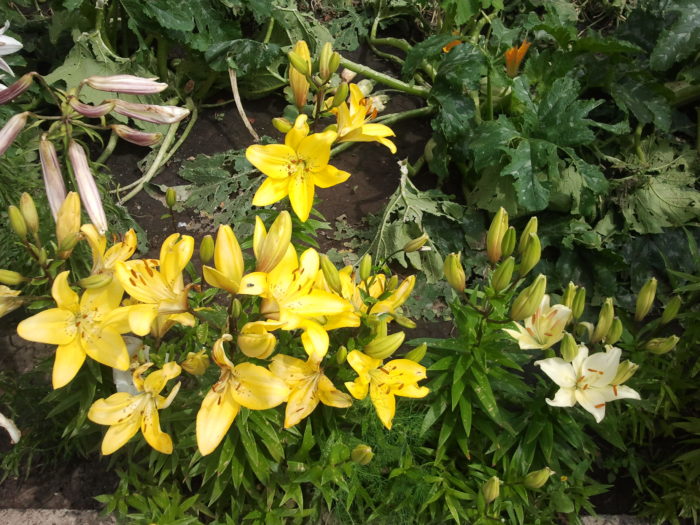 Yellow lilies
Yellow lilies
Popular combinations
Climbing roses are often planted against the background of a high wall, and lily bulbs are placed in front of them. This is beautiful, but only suitable for large spaces, for example, near the porch of a house or around a gazebo. In these places, children often play and can trample small plants, and tall lilies are allowed to be planted near the wall, under the branches of roses. In such a neighborhood, they will feel quite good. Plant a few hosta bushes at the roots.The plant remarkably mulches the ground and grows so that it will be rather difficult not to notice and trample it, as well as the stems of lilies stretching out from under its wide leaves. A beautiful flower bed with lilies surrounded by a host is also presented in our material.
Bearded irises
Bearded irises are very common in landscape design. They combine several classes and are the largest group. They differ in height, which must be taken into account when using them in landscape design.
The creation of a radarium in the garden is very interesting. This is a flower garden that is built on a composition from one culture. Its dimensions correspond to the size of an average flower bed.
Irises are in demand in garden landscaping. With the right iris combinations, your garden design can be completely transformed. Several varieties of irises of different colors can be placed in the iridarium. Landings are carried out in groups, the gap between them is filled with small pebbles. At the same time, do not forget to leave free space, which overgrown plants will fill as they grow.
Important! Plants are not recommended to be planted in rows; it is better to plant asymmetrically, like on an alpine slide. Borders can be either indistinct or limited by stones of various sizes
Borders can be either indistinct or limited by stones of various sizes.
Interesting. The iridarium will look harmonious even on a retaining wall.
You can supplement such a flower garden with the help of cereals, but you should not be zealous, 2-3 groups of cereals are enough. Ceramics or various forging are used as decoration for the iridarium. These can be vessels of various shapes, original benches and bridges, carved fence.
How beautiful to plant irises? Additional decorations of the iridarium are very important - the period of flowering of irises is not very long. The rest of the time, the flower garden will simply delight the eye with greenery. Therefore, the introduction of additional elements is necessary.
Bearded irises are striking in their beauty and diversity - they can be either one-color or two-color, two-tone, iridescent and edged. With their help, it is easy to decorate the landscape, creating a bright flower garden out of it.
More on the topic "Do-it-yourself flower bed in the country":
I saw someone planted stone roses from the concrete pipes of the flower bed
How to make a flower garden in the country with your own hands. Flower beds and flower beds with annuals and perennials, mixborder. Do-it-yourself flower bed and flower garden: petunia, begonia, perennials, bulbous. Weeds in a flower garden are a very hot issue.
I'm all about a flower bed under a birch)
How to create a flower bed in the country. A flower garden of annual and perennial plants. Thank you. I'm an experienced florist, but it's still interesting, because I know many flowers without a name and I go to the garden to appear in commercials. described herself. do-it-yourself flower bed in the country for beginners.
What is the ideal planting on the south side of the house in the sun?
Summer cottage, garden and vegetable garden. Dacha and dacha plots: buying, landscaping, planting trees and shrubs, seedlings Look at other discussions on "what to plant from the south side of the house in the dacha" Do-it-yourself garden: what seedlings to buy, what trees to get rid of.
what flowers to plant in the cemetery now?
A bag of 25 liters is enough for a standard flower garden. Mix it with the existing soil in half. A flower bed for beginners. How to create a flower bed on the site.
A wide variety of perennials
Beds and flower beds for the garden - do it yourself. 10 interesting ways. Do-it-yourself flower bed and flower garden: petunia, begonia, perennials, bulbous.
Advise perennials for flower beds
Advise perennials for flower beds. Flowers. Summer cottage, garden and vegetable garden. Dacha and country plots Advise perennials for flower beds. Girls, advise what you can put on ...
Flower bed
Flower bed. Flowers. Summer cottage, garden and vegetable garden. Dacha and dacha plots: buying, landscaping, planting trees and I have two beautiful flower beds with lilies in my dacha - beauty. How to make a flower garden in the country with your own hands.Flower beds and flower beds with annuals and perennials, mixborder.
how to fill up empty spaces in the flower beds?
I saw pictures, the gaps between the plants are covered with something that looks like small chips, and also pebbles such as small gravel (?). Who knows what it is, where to get it and how it looks in real life? Helps to protect from weeds, retains moisture? Tell me who knows.
How beautiful to plant a bunch of lilies from Helen_sun?
A flower bed for beginners. By the way, now in the store you can buy dahlia tubers, gladioli bulbs, lily bulbs. Having planted them in May at your site, you will enjoy flowering ...
how to make a flower garden outside the window?
Land for a flower bed. How to make a flower garden in the country with your own hands. Flower beds and flower beds with annuals and perennials, mixborder. A flower bed for beginners. How to create a flower bed on the site. A flower garden of annual and perennial plants. Flower beds in the country: how to make ...
Making a flower bed with conifers
How to make a flower garden in the country with your own hands. Flower beds and flower beds with annuals and A beautiful lawn near the house, a well-groomed flower bed and a garden is the dream of any homeowner, or On the other hand, I understand perfectly well that a child cannot be happy in a family where ...
Flower bed barbie
Flowerbed Barbie. It so happened that I almost completely dropped out of needlework. But hands still I will support the idea with bottles as soon as I have a stationary place for flower beds.
Land for flower beds
Land for a flower bed. Arrangement of the site. Summer cottage, garden and vegetable garden. I dug the flower bed onto the bayonet of a shovel, turning over each lump. After a few days, you need to comb it with a rake, pull out the dried roots of the weeds with your hands and level it.
a fence for a flower bed
a fence for a flower bed. Arrangement of the site. Summer cottage, garden and vegetable garden. a fence for a flower bed. Tell who is fencing the flowerbeds and beds with what, so that dogs and children do not trample.
The simplest flower bed.
The simplest flower bed. Give an idea of how to make the simplest flower bed in the schoolyard. (The area is small). The problem is: 1) very limited funding ...
Flower bed in the room
A flower bed in the room. Place for flowers in the house .. Floriculture. Has anyone made a flower bed in the living room? If yes, then share how they waterproofed it, what was laid under the ground ...
Flower bed scheme?
Flower bed scheme?. Landscaping. Summer cottage, garden and vegetable garden. Summer cottage and suburban areas: purchase, improvement, planting trees and shrubs, seedlings, beds, vegetables, fruits, berries ...
Flower bed exhibition
Flower gardens in the country: how to make a mixborder and a raised flower garden. Evergreen garden. The exhibition will be woven into the historical landscape Do-it-yourself flower beds and flower beds: beautiful view and easy maintenance. Lysikov Andrey. Flower beds in the country: how to make a mixborder and ...
How to designate flower beds?
Do-it-yourself flower beds and flower beds: beautiful view and easy maintenance. How to make a flower garden in the country with your own hands. It is better to designate the circumference of the flower bed with something.
How to properly break a flower bed with your own hands
To get a harmonious flower bed, it is worth choosing the right planting layout. It is recommended to choose crops that match in color and size. Solid varieties look good with variegated ones, and dark ones with light ones. It is not worth planting several multi-colored varieties on the same flower bed. Otherwise, they will mix. Plants in a flower garden should not shade each other. Irises are distinguished by a superficial root system, therefore, in addition to them, it is worth choosing plants with deep roots.
The spacing should be observed between the plants. It is imperative to systematically loosen the soil and get rid of weeds. Cultures should be selected according to the flowering time. Due to this, some plants will fade, while others will begin to bloom.
Where to plant lilies, choose a landing site, neighbors
 As we have already noted, depending on the origin, lilies need different illumination.Tubular and Orleans hybrids grow well in full sun, Curly and Oriental require placement in partial shade, Asiatic and LA hybrids prefer light shading.
As we have already noted, depending on the origin, lilies need different illumination.Tubular and Orleans hybrids grow well in full sun, Curly and Oriental require placement in partial shade, Asiatic and LA hybrids prefer light shading.
To emphasize the beauty of a lily, you need to choose the right neighbors. In this case, the height of the plant, the time and duration of flowering, the size and color of the flower should be taken into account. It is believed that lilies look especially impressive with blue perennials (delphinium, sage, blue blue, small-leaved, bell, mordovnik).
Phloxes are also suitable as neighbors, but not tall with bright flowers, but undersized blue ones. In spring they look good during regrowth and flowering, in summer they form a beautiful border of shiny leaves. In addition, creeping phlox serve as a kind of mulch for lilies.
Peonies are very good neighbors. They bloom earlier, and then their magnificent carved foliage becomes a wonderful backdrop for blooming lilies. By the way, you can plant bulbs both in front and behind the peonies. But irises and roses are not good neighbors.
Lilies look picturesque against the background of dark junipers, thuja.
They are also good among the greenery of such plants as ferns, cuffs, coleus.
The planting of lilies in bushes on the lawn is very beautiful. However, after they have faded, empty spaces remain. They can be filled with stunted plants that bloom later (pansies, marigolds).
Lily in a flower garden: example 2

FLOWER 2: "LUXURY UPREST"
The composition shown in the photo looks downright natural ... If not for one "upstart" that jumps out in the center of the flower garden - a lily Friso, OT-hybrid with huge, like waxy, flowers, white along the edge of the petals, purple-red in the center, and the neck is bright yellow. But somehow she's not annoying at all. Surrounded by Nivyanik and Perovskiy, it looks quite harmonious. And the background for this composition is the common twig.
A very beautiful plant, but not for us, unfortunately. We can only replace it with David's buddle, which forms a rather large bush, for example, varieties Orchid Beauty with pale, purple inflorescences, Empire blue - with blue-violet or Black knight - with purple, and you can also plant a natural form from this buddley - f. Vicha: it is taller, it has large inflorescences that bloom in early August.
Types of flower beds
Very often a flower bed is associated with this concept. In fact, it is only one of the types. There are also the following:
- discounts;
- mixborders (mixed continuous flowering);
- single and group landings;
- color spots;
- modular options.
There are also more complex compositions. They are usually created by professionals in gardens and parks. The article will consider the simplest options, such as a mixed flower garden, modular and an annual flower bed. A diagram, a photograph and a short description of the plants will help you realize what you see with your own hands. Focusing on the indicated types of plants, you can purchase them of the shade that suits you best, if you did not really like what you saw on the template.
In specialized books, magazines, on the Internet, you can find many ready-made templates of different configurations, combinations of shades, types and varieties of ornamental floral plants. The simplest to implement will be the scheme of a flower bed of annuals. Every year, in the same space, you will be able to create different compositions. Annual shrubs grow faster and produce a lot of buds. In addition, seedlings of these flowering plants will cost less.

Perennials are usually planted at a fairly large distance, since after a few years the number of shoots and shoots increases significantly. If planted too close initially, the plants will interfere with each other. The creation of a flower garden from perennials is more laborious.In addition, in the first season, some plants may not bloom at all or give few buds, and there will be a lot of empty space between the bushes, which will still have to be filled with annuals.

